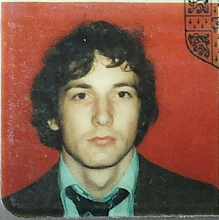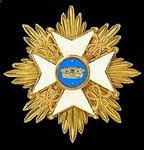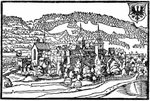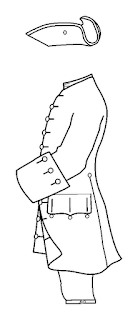Monday, 24 December 2012
A Happy Xmas and New Year To Everyone
Just a hasty message to wish you all a Happy Xmas and New Year. I was hoping to post one or two of the French Minden flags but that will have to wait until after Xmas now, I'm afraid. I've just run out of time, energy and all, before being submerged in the giddy and exhausting social round that is Xmas*. (Well, a very busy Xmas Eve awaits tomorrow, anyway.)
All good wishes,
David.
[* a somewhat exaggerated and satirical comment. ;-)]
Posted by
David Morfitt
at
Monday, December 24, 2012
7
comments
![]()
Monday, 12 November 2012
New Generic French Infantry Template
I was never very happy with the first generic French infantry template I did. It was crude and anatomically rather odd - looking much as if the man was overweight and somewhat slumped! So here's an improved version looking rather more upright, slim and soldierly... His tricorne is also improved.
I shall eventually redo all the French uniforms for Quebec that were previously based on the poor first template, with all the appropriate pocket and cuff variations.
I've now added the template coloured (and slightly modified) to represent the French infantry regiment La Sarre, one of the Quebec regiments whose flags I have already posted on the blog.
First raised 1651, the 2 battalion infantry regiment La Sarre supplied
its 2nd battalion for the war in Canada. It arrived in 1756 as part of
the convoy carrying the new commander Montcalm. It was at the capture of
Oswego 1756; the capture of Fort William Henry 1757; the French victory
of Ticonderoga 1758; the siege of Quebec and battles of Montmorency and
the Plains of Abraham; elements surrendered at Fort Niagara 1759; it was
at the French victory of Sainte Foy and the siege of Quebec 1760; and
finally it was on the retreat to and at the surrender at Montreal 8th September 1760.
Only the ordonnance flag was carried in Canada and was burned before the
surrender at Montreal.
Also now added below the French Infantry Regiment Guyenne, another Quebec regiment.
Posted by
David Morfitt
at
Monday, November 12, 2012
12
comments
![]()
Monday, 3 September 2012
New mini project - French flags of the battle of Minden 1759
I really like the elegance and style (as well as pleasing simplicity of many) of the 18th century French flags. Having now finished doing the flags of the regular French regiments that fought at Quebec I think I may well take a stab at doing the flags (infantry, at least) of the French army at Minden 1759. Watch this space! :-)
Posted by
David Morfitt
at
Monday, September 03, 2012
9
comments
![]()
Thursday, 9 August 2012
Flags of French Béarn Infantry Regiment - French infantry in Canada series No.7
And finally, the last of the French (regular) infantry in Canada flag series.
First raised 1684, the 2 battalion infantry regiment Béarn supplied its 2nd battalion for the war in Canada. It arrived in 1755. It was at the capture of Oswego in 1756; the capture of Fort William Henry in 1757; the victory of Ticonderoga 1758; the siege of Quebec and battles of Montmorency and the Plains 1759; the surrender of Fort Niagara 1760 (detachment); the victory of Ste. Foy and siege of Quebec 1760; and finally surrendered with the others at Montreal on the 8th September 1760, where the colours were all burned to prevent capture. The captured battalion returned to France in 1760 and the regiment was disbanded on the 25th November 1762. Only the ordonnance flag as depicted here was carried in Canada.
Posted by
David Morfitt
at
Thursday, August 09, 2012
12
comments
![]()
Friday, 13 July 2012
English Civil War flags - Royalist Infantry 1
These are two infantry colours carried by the small Royalist infantry regiment of Colonel Francis Cooke. The unit was probably raised in 1643 in the south-west and it fought at Cheriton, Cropredy Bridge, Lostwithiel and 2nd Newbury. Three colours for the unit were recorded by Symonds at the Aldbourne Chase muster in April 1644, suggesting the unit counted 3 companies (at one flag per company), and these flags represent two of those. Cooke was captured in Salisbury in December 1644. He also raised a small cavalry unit. (Most information from Stuart Reid's invaluable series of booklets "Officers and Regiments of the Royalist Army", Partisan Press. On infantry colours of the ECW, "E.C.W. Flags and Colours: 1: English Foot" by Stuart Peachey and Les Prince, also Partisan Press, is an excellent summary and assessment of all the reliable sources of material.)
The material of these often short-lived infantry flags of the ECW was usually taffeta or sarcenet, a soft silk cloth, probably of lighter bulk than 18th century flags and less durable. I've experimented a good deal with trying to make the flags seem more "see through" than 18th century flags but am still not entirely happy with the results. Anyway, this is where I've arrived with them at the moment and at the price people can't really complain. :-)
Posted by
David Morfitt
at
Friday, July 13, 2012
12
comments
![]()
Tuesday, 19 June 2012
Things Are Happening Behind The Scenes...
In case people think nothing is happening with the blog at the moment, I thought I'd mention that, amongst other things, I'm revamping a number of the early templates which I now feel are somewhat crude - initially I'm working on the French and Austrian infantry but ultimately quite a number of templates will have a makeover. I'm also producing coloured versions of a number of templates (e.g. the British) that originally had only outline templates. It all takes time, though, and so for the moment I don't have very much to put on the blog.
Posted by
David Morfitt
at
Tuesday, June 19, 2012
0
comments
![]()
Tuesday, 24 April 2012
Generic General-Type Template - of the fanciful variety!
I was playing around with one of the elaborately laced Royal Navy templates and also producing a feather-edged tricorne, of the type worn by generals in the 18th century (not to mention Baron von Munchhausen; rewatched the Terry Gilliam film recently ;-)), and the result was, I think, rather pleasing. I aim to create some authentic generals' uniforms (hence the feather-edged tricorne), which are long overdue, but in the meantime this is a pleasant, if rather fanciful, version. (Then again, given the freedom generals of that period had in inventing their own uniforms, I wouldn't be at all surprised if someone somewhere wore this exact uniform! :-))
I haven't yet created a blank for this, as to show the feather detail in a non-vector format the template needs to be very big, but these do show what fun can be had with recolouring some of the templates already created.
Update: I've now added a somewhat Russian-style general's uniform in green and red - also rather attractive, I think. :-)
Update 2: Added a rather Austrian-like variant in white and red and a French-like variant in blue and red.
Posted by
David Morfitt
at
Tuesday, April 24, 2012
9
comments
![]()
Saturday, 21 April 2012
Saxon Surgeon
Almost every army of the period had rather too many underqualified drunken sawbones, as Christopher Duffy confirms in his books, the only notable exception being the Austrian army which tried with some success to regulate and improve the medical profession in its army. Of course there were always some conscientious surgeons who did what they could with the little knowledge and resources they had. However, in a time without anaesthetics or anti-biotics, and with the medical profession lacking most of the knowledge that medicine has acquired since the 19th century, any wound on the battlefield was a potential death sentence; as Christopher Duffy says, every soldier of the period had to face battle "in the knowledge that the slightest wound might condemn him to the most terrible and lingering death" ("The Military Experience in the Age of Reason", page 318).
Posted by
David Morfitt
at
Saturday, April 21, 2012
0
comments
![]()
Tuesday, 10 April 2012
Sunday, 8 April 2012
WSS Grenadiers' Preview
Just a quick preview shot of the next 6 variants of WSS infantry with 3 different versions of the early grenadier cap. I'll post them on the blog in the next few days.
I thought it best to keep the caps simple so they're more adaptable - if I used specific designs, especially of the detail of the frontplates, they'd be far less widely useful without further editing.
Posted by
David Morfitt
at
Sunday, April 08, 2012
4
comments
![]()
Saturday, 7 April 2012
Thursday, 5 April 2012
WSS Infantry Template 1
Note that the rapidity (or even appearance at all) of new WSS infantry templates will quite probably depend on the response I receive for this one, as my To Do list is now very long!
UPDATE: I didn't export the image with its 256 colour palette the first time I uploaded it to my blog so it will almost certainly not colour in properly – I've fixed that now and you can get the updated image from the blog. That comes of doing things when very, very tired! Sorry about that…
Posted by
David Morfitt
at
Thursday, April 05, 2012
12
comments
![]()
Friday, 3 February 2012
Colours of French Artois Infantry Regiment - French infantry in Canada series No.6
We are near to completing the French in Canada flag series with this, the Artois regiment.
First raised 1610, the 2 battalion infantry regiment Artois supplied its 2nd battalion (13 companies strong) for the war in Canada. It arrived in 1755, garrisoned Louisbourg and was captured at the capitulation of the fortress in July 1758. The captured battalion was sent to Great Britain and exchanged at Calais in December 1758. Only the ordonnance flag was carried in Canada but the colonel's colour is shown here for completeness.
Posted by
David Morfitt
at
Friday, February 03, 2012
7
comments
![]()




































